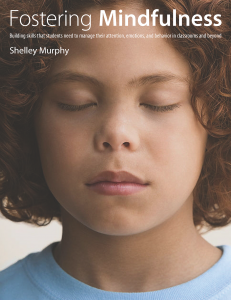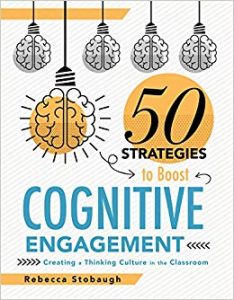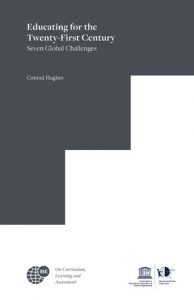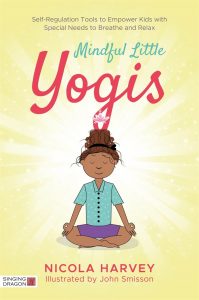Fostering mindfulness : building skills that students need to manage their attention, emotions, and behavior in classrooms and beyond, Shelley Murphy
 This resource by OISE instructor Shelley Murphy is a must-have for any educator curious and committed to building practices of mindfulness into their classroom culture. The useful templates, sheets, scripts, and images contained within this resource allow it to easily guide your classroom’s developing and ongoing mindfulness program. The content of the text is appropriately scaffolded – the first chapter beginning with a clear, concise, and current definition and discussion of mindfulness in general, and building in the context of emotion, attention, behaviour, and the benefits to the greater world community. Each of the seven proceeding chapters surround specific classroom strategies, grounded in the practice of mindfulness, and accompanied by a definition of terms, multiple sections of practical advice and strategies, as well as designed classroom activities and activities to ensure that every educator has the opportunity to incorporate these stress-relieving practices as stress-free as possible. While on the surface it appears the majority of the classroom activities discussed and handouts provided are best suited for primary grade students, the author provides many clear extensions to each activity or idea that allow them to easily be integrated into junior and intermediate classroom spaces.
This resource by OISE instructor Shelley Murphy is a must-have for any educator curious and committed to building practices of mindfulness into their classroom culture. The useful templates, sheets, scripts, and images contained within this resource allow it to easily guide your classroom’s developing and ongoing mindfulness program. The content of the text is appropriately scaffolded – the first chapter beginning with a clear, concise, and current definition and discussion of mindfulness in general, and building in the context of emotion, attention, behaviour, and the benefits to the greater world community. Each of the seven proceeding chapters surround specific classroom strategies, grounded in the practice of mindfulness, and accompanied by a definition of terms, multiple sections of practical advice and strategies, as well as designed classroom activities and activities to ensure that every educator has the opportunity to incorporate these stress-relieving practices as stress-free as possible. While on the surface it appears the majority of the classroom activities discussed and handouts provided are best suited for primary grade students, the author provides many clear extensions to each activity or idea that allow them to easily be integrated into junior and intermediate classroom spaces.
50 strategies to boost cognitive engagement : creating a thinking culture in the classroom, Rebecca Stobaugh
 Rebecca Stobaugh’s resource is rich with activity ideas and templates that allow educators to easily access and incorporate mindfulness practices in their K-12 classroom. The content is divided into 8 chapters that introduce and contextualize critical thinking and cognitive engagement and extend these ideas to specifically address processes of: understanding, analyzing, evaluating, and creating level thinking. The content focuses on cultivating a classroom focused on a culture of thinking, rather than stand-and-deliver instruction. The targeted skill development aims to enrich the students’ engagement and critical thinking to benefit their lives above and beyond in-class success. This text provides strategies to create an active learning environment that provides an infrastructure for a thinking classroom culture – tackling the disparity between 20th century pedagogy and 21st century real-world skill demand. These 50 strategies are a fantastic and cohesive addition to any K-12 classroom through the variety of clear objectives, diagrams, classroom examples, and checkpoints!
Rebecca Stobaugh’s resource is rich with activity ideas and templates that allow educators to easily access and incorporate mindfulness practices in their K-12 classroom. The content is divided into 8 chapters that introduce and contextualize critical thinking and cognitive engagement and extend these ideas to specifically address processes of: understanding, analyzing, evaluating, and creating level thinking. The content focuses on cultivating a classroom focused on a culture of thinking, rather than stand-and-deliver instruction. The targeted skill development aims to enrich the students’ engagement and critical thinking to benefit their lives above and beyond in-class success. This text provides strategies to create an active learning environment that provides an infrastructure for a thinking classroom culture – tackling the disparity between 20th century pedagogy and 21st century real-world skill demand. These 50 strategies are a fantastic and cohesive addition to any K-12 classroom through the variety of clear objectives, diagrams, classroom examples, and checkpoints!
Educating for the twenty-first century : seven global challenges, Conrad Hughes
 This is a fundamentally important text for educators concerned with the future of educational policy and its implementation modern classrooms, looking for philosophical refuge and meaningful exploration. Despite the book’s title, it is not catered solely towards those involved professionally in education – Hughes argues the education is, and increasingly should be, a universal concern. Hughes positions education at the forefront of social change. He addresses the conflicting perception of education existing simultaneously as a hub for societal development and the source of societal unpreparedness in light of the rapid technological, environmental, and socioeconomic changes. He calls attention to many of the over-used and under-effective buzzwords that have emerged in the field, and that have unsuccessfully combated the disparity between what is being taught in schools, and what is needed to exist in this changing world. Through this lens, he addresses mindfulness, singularity (artificial intelligence), terrorism, sustainability, post-truth politics, knowledge, and character. Each chapter provides experience-driven advice from a current administrative professional to ensure students are informed and prepared for the world they inhabit.
This is a fundamentally important text for educators concerned with the future of educational policy and its implementation modern classrooms, looking for philosophical refuge and meaningful exploration. Despite the book’s title, it is not catered solely towards those involved professionally in education – Hughes argues the education is, and increasingly should be, a universal concern. Hughes positions education at the forefront of social change. He addresses the conflicting perception of education existing simultaneously as a hub for societal development and the source of societal unpreparedness in light of the rapid technological, environmental, and socioeconomic changes. He calls attention to many of the over-used and under-effective buzzwords that have emerged in the field, and that have unsuccessfully combated the disparity between what is being taught in schools, and what is needed to exist in this changing world. Through this lens, he addresses mindfulness, singularity (artificial intelligence), terrorism, sustainability, post-truth politics, knowledge, and character. Each chapter provides experience-driven advice from a current administrative professional to ensure students are informed and prepared for the world they inhabit.
Mindful little yogis : self-regulation tools to empower kids with special needs to breathe and relax, Nicola Harvey
 Educators have the unique opportunity to provide their students with increasingly important self-regulatory techniques at a young age – allowing them to build and connect with their emotions and manage stress in healthy ways. While the content of this new resource is created to benefit children with special needs, any classroom culture can benefit from the tools, techniques, and activities discussed in Harvey’s work. Mindful Little Yogis aims to guide and provide parents, teachers – or anyone interacting with children – with the tools they need to recognize, acknowledge, and celebrate their various feelings and emotions. Rich with diagrams and student-ready work sheets, each of the five chapters serve as a practical guide that carries young people through breathing exercises – and other useful self-regulation tools – that can be easily integrated into any classroom setting. The book begins by introducing and contextualizing SEN (special education needs), and how the ideas and practices introduced throughout the resource can provide benefits to this population. The second chapter introduces healthy breathing exercises, followed by an introduction to yoga-breathing activities in chapter 3. Chapter 4 delves into self-regulation tools, and chapter 5 provides additional helpful strategies that go above and beyond the “textbook” understanding of SEN students and their unique classroom experiences. Excellent additional sources of information, such as a developmental skills glossary, additional resources, and references, are located after the conclusion. This is a must-have for teachers aiming to start their school year with cultivating a calm and centered classroom culture!
Educators have the unique opportunity to provide their students with increasingly important self-regulatory techniques at a young age – allowing them to build and connect with their emotions and manage stress in healthy ways. While the content of this new resource is created to benefit children with special needs, any classroom culture can benefit from the tools, techniques, and activities discussed in Harvey’s work. Mindful Little Yogis aims to guide and provide parents, teachers – or anyone interacting with children – with the tools they need to recognize, acknowledge, and celebrate their various feelings and emotions. Rich with diagrams and student-ready work sheets, each of the five chapters serve as a practical guide that carries young people through breathing exercises – and other useful self-regulation tools – that can be easily integrated into any classroom setting. The book begins by introducing and contextualizing SEN (special education needs), and how the ideas and practices introduced throughout the resource can provide benefits to this population. The second chapter introduces healthy breathing exercises, followed by an introduction to yoga-breathing activities in chapter 3. Chapter 4 delves into self-regulation tools, and chapter 5 provides additional helpful strategies that go above and beyond the “textbook” understanding of SEN students and their unique classroom experiences. Excellent additional sources of information, such as a developmental skills glossary, additional resources, and references, are located after the conclusion. This is a must-have for teachers aiming to start their school year with cultivating a calm and centered classroom culture!
 Gabi Garcia has created a colourful and insightful picture-book that takes children (and parents!) on a process of connecting physical sensations and emotions through exploration, vocabulary development, and self-monitoring exercises. The book opens with “A note to parents and teachers” – encouraging parents to show up for their child by participating in this guide, and modeling positive self-monitoring and body-listening. Garcia includes additional opportunities for continued learning through listing extension activities for parents and / or teachers and children to work through together. Each page is covered with vibrant images depicting common body sensations and is accompanied by a “Let’s Practice!” section – inviting the child to participate in an activity that connects their physical sensations to verbal descriptions and activates a process of total physical recall. The book closes with a vocabulary list divided by “sensations” and “feelings”, and an invitation to add to this list with your child or student – as well as a list of “practice” activities to continue to build. Listening to my body serves as an excellent resource for all parents and teachers looking to foster positive body-consciousness and a strong sense of emotional intelligence in their child or student!
Gabi Garcia has created a colourful and insightful picture-book that takes children (and parents!) on a process of connecting physical sensations and emotions through exploration, vocabulary development, and self-monitoring exercises. The book opens with “A note to parents and teachers” – encouraging parents to show up for their child by participating in this guide, and modeling positive self-monitoring and body-listening. Garcia includes additional opportunities for continued learning through listing extension activities for parents and / or teachers and children to work through together. Each page is covered with vibrant images depicting common body sensations and is accompanied by a “Let’s Practice!” section – inviting the child to participate in an activity that connects their physical sensations to verbal descriptions and activates a process of total physical recall. The book closes with a vocabulary list divided by “sensations” and “feelings”, and an invitation to add to this list with your child or student – as well as a list of “practice” activities to continue to build. Listening to my body serves as an excellent resource for all parents and teachers looking to foster positive body-consciousness and a strong sense of emotional intelligence in their child or student!
